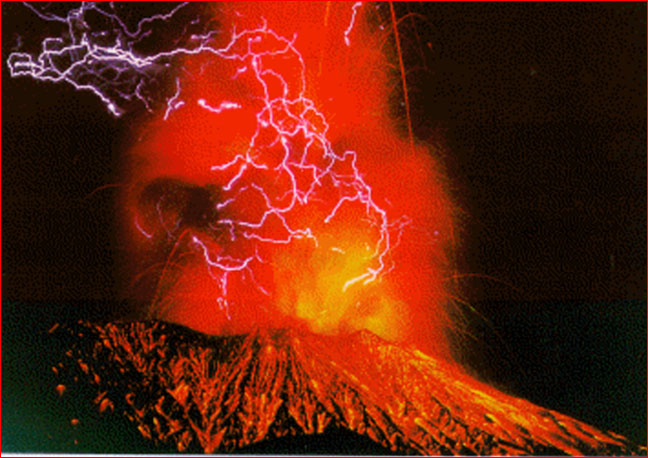
AND NOW...
A compilation of utterly useless information brought to you by www.strikealert.com and www.nationalgeographic.com
Remembering U.S. Golfer Lee Trevino getting struck by lightning at the Western Open on June 28th, 1975, TNNWC proudly presents:
Amazing Facts About Lightning
 |
| Ball Lightning |
- Lightning is a form of electrical discharge between clouds or between a cloud and the ground.
- The discharge may take place between two parts of the same cloud, between two clouds, or between a cloud and the ground.
- Lightning may appear as a jagged streak, a flash in the sky, or in the rarer form of a brilliant ball.
- Thunder is the sound waves produced by the explosive heating of the air in the lightning channel during the return.
- Most lightning strikes occur either at the beginning or end of a storm.
 |
| Volcanic Lightning |
- Lightning is not confined to thunderstorms. It's been seen in volcanic eruptions, extremely intense forest fires, surface nuclear detonations, heavy snowstorms, and in large hurricanes.
- The average lightning strike is six miles long.
- Lightning reaches 50,000 degrees Fahrenheit, fours times as hot as the sun's surface.
- A cloud-to-ground lightning channel can be 2 to 10 miles long.
- Voltage in a cloud-to-ground strike is 100 million to 1 billion volts.
- Lightning is underrated as a risk because it usually claims only one or two victims at a time and does not cause mass destruction of property.
- Lightning affects all regions. Florida, Michigan, Pennsylvania, North Carolina, New York, Ohio, Texas, Tennessee, Georgia, and Colorado have the most lightning deaths and injuries.
- Lightning kills more people on an annual basis than tornadoes, hurricanes or winter storms. It is second only to flash floods in the annual number of deaths caused by storm-related hazards.
- Damage costs from lightning are estimated at $4-5 billion each year in the U.S.
- Around the earth there are 100 lightning strikes per second, or 8,640,00 times a day.
- What is commonly referred to as heat lightning, is actually lightning too far away to be heard. However, the storm may be moving in your direction.
- There are approximately 100,000 thunderstorms in the U.S. each year.
- Americans are twice as likely to die from lightning than from a hurricane, tornado or flood.
 |
| Golfer Lee Travino after lightning strike |
- Rubber shoes do nothing to protect you from lightning.
- Talking on the telephone is the leading cause of lightning injuries inside the home.
- Standing under a tall tree is one of the most dangerous places to take shelter.
- If your hair stands up in a storm, it could be a bad sign that positive charges are rising through you, reaching toward the negatively charged part of the storm. That's not a good sign! Your best bet is to get yourself immediately indoors.
- The Federal Emergency Management Agency (FEMA) estimates there are 200 deaths and 750 severe injuries from lightning each year in the U.S.
 |
| Blue Lightning |
- The odds of becoming a lightning victim in the U.S. in any one year is 1 in 700,000.
- The odds of being struck in your lifetime is 1 in 3,000.
- 20% of all lightning victims die from the strike.
- 70% of survivors will suffer serious long-term effects.
- Annually, there are more than 10,000 forest fires caused by lightning.
- 85% of lightning victims are children and young men aged 10-35 engaged in outdoor recreation and work activities outside.
- 70% of all lightning injuries and fatalities occur in the afternoon.
- Most lightning deaths involve people working outdoors and outdoor recreationists.
- Lightning in remote terrain creates dangerous conditions. Hikers, campers, backpackers, skiers, fishermen, and hunters are especially vulnerable when they're participating in these activities.
- Many survivors of lightning strikes report that immediately before being struck their hair was standing on end and they had a metallic taste in their mouth.
- If you can hear thunder, you are within 10 miles (16 kilometers) of a storm—and can be struck by lightning. Seek shelter and avoid situations in which you may be vulnerable.
- Use the 30-30 rule, when visibility is good and there is nothing obstructing your view of the thunderstorm. When you see lightning, count the time until you hear thunder. If that time is 30 seconds or less, the thunderstorm is within six miles (ten kilometers) of you and is dangerous. Seek shelter immediately.
- The Fourth of July is historically one of the most deadly times of the year for lightning in the U.S.. In summer, especially on a holiday, more people are outside, on the beach, golf course, mountains, or ball fields. Outdoor jobs such as construction and agriculture, and outdoor chores such as lawn mowing or house painting are at their peak, putting people involved in danger.
- Long-term injuries from a lightning strike can include memory & attention loss, chronic numbness, muscle spasms & stiffness, depression, hearing loss, and sleep disturbance.
- Some scientists think that lightning may have played a part in the evolution of living organisms. The immense heat and other energy given off during a stroke has been found to convert elements into compounds that are found in organisms.
- ----------------------------------------------------------------------------
We strongly encourage READER PARTICIPATION.
HEY YOU! Yes you. You are invited to submit your own favorite amazing fact or statistic. If you’d like, we’ll even publish your name (or your organization’s name) and give you credit for your contribution. Note: Unless you are particularly dense, you will recognize that we are actually offering you FREE PUBLICITY in exchange for a mere tidbit of information.
Simply click on the hyperlink below to submit your gem:
If the hyperlink above isn’t working, first you must first blame your browser (Internet Explorer 8 seems to be an exceptionally popular source of consumer dissatisfaction), then your ISP Provider, then Bill Gates (or Steve Jobs), and mutter a rapid string of profanities under your breath. Kick furniture if you feel it necessary. [Feel better?] Then, just click on this one, and get direct access.
Powered By TNNWC Group™
For complete tactical and strategic business planning, marketing, media, lead-generation, technological and capital resources, scalable solutions and tools to support every entrepreneurial start-up, young enterprise, small- to medium-sized business and emerging high-growth company, talk to The National Networker Companies™/ TNNWC Group, LLC.We are a collaborative entrepreneurial, creative organization offering you hands-on, personalized assistance in every aspect of achieving your monetization, profitability and financial sustainability objectives, domestically and globally.
We don’t just coach you or offer you pre-packaged, push-button solutions – we listen to you, analyze your exact needs, and work within your budget to: 1) create your tool kit and 2) work as your partner to implement your plan by supporting you in the most efficient and productive use of every tool.
Visit our website, which is located at http://www.TNNWC.com .
To receive our newsletters, publications, information bulletins and alerts, simply join us as a Member. Membership is free and the benefits are unequalled anywhere.
Just go to our home page, and click on the “JOIN US” button.

Capital, Traffic Building, International Customers and unique SERVICES.
The National Networker Publications™ produced by TNNWC Group, LLC
Forward/Share This Article With Colleagues And Social Media:











No comments:
Post a Comment